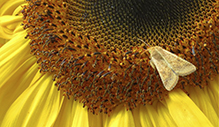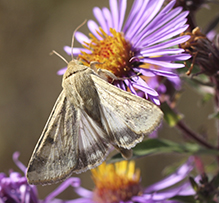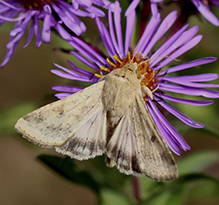corn earworm moth
(Helicoverpa zea)
Conservation • Description • Habitat • Ecology • Distribution • Taxonomy
|
||||||||
| Hodges # | 11068 |
|||||||
Conservation Status |
||||||||
| IUCN Red List | not listed |
|||||||
| NatureServe | NNR - Unranked SNR - Unranked |
|||||||
| Minnesota | not listed |
|||||||
Description |
||
Corn earworm moth is a medium-sized, late season, flower moth. It occurs across the United States and southern Canada, in Mexico, in Central America, and in South America. It is common in Minnesota. Larvae feed on a wide variety of herbaceous plants. It is a major pest of many agricultural crops, including corn, tomatoes, and cotton. Other common names for it are tomato fruitworm and cotton bollworm. Adults do not survive northern winters. They migrate north every year, first appearing in Minnesota in late July or in August, depending on the severity of the preceding winter. They are found in croplands, old fields, and other open disturbed areas. Adults are 11⁄16″ to ⅞″ (18 to 22 mm) in length and have a 1¼″to 1¾″ (32 to 45 mm) wingspan. Moth size is often given in terms of forewing length, which in this case is ⅝″ to ¾″ (16 to 20 mm). The forewing of the female is yellowish-brown to orangish-brown and mottled with gray to reddish-brown. The terminal area is lighter and the subterminal area is usually darker. The lines are light gray, orangish-brown, or the same color as the background but darker. On some individuals they are faint and barely perceptible. The basal and antemedial (AM) lines are scalloped with the scallops pointed rearward. The AM line has dots at the bases of the scallops. The median line is wavy. The postmedial (PM) and subterminal lines are scalloped with the scallops pointing forward. There is a dark dot, often with a smaller white spot, at the base of each scallop. The terminal line is represented as a row of small dots between the veins. The orbicular spot is round and the same color as the wing background but with a dark spot in the center and a thin faint outline. The reniform spot is similar but kidney-shaped and with a dark blotch in the center. The fringe is darker than the terminal area. The hindwing is pale brownish-white with dark gray veins; a dark, bar-like discal spot; a broad dark terminal band; and a white fringe. The terminal band has two pale spots near the outer margin. The male is similar but lighter and with a green to olive cast. The caterpillar is up to 1 9⁄16″ (4 cm) long and is highly variable in color. It may be pale tan, yellow, orange, red, maroon, green, dark brown, or nearly black. The body is covered with minute black spines, but these are visible only under magnification. Longitudinal stripes on the body may be well-defined, diffuse, or faint. There is a thin dark stripe in the middle (middorsal), a dark stripe on each side above the breathing pores (spiracles) and a pale stripe below the spiracles. On the first segment of the thorax there is a pair of stiff hairs (setae). Unlike most noctuid moth caterpillars, these setae are aligned horizontally, parallel to the body axis. |
||
Size |
||
Total length: 11⁄16″ to ⅞″ (18 to 22 mm) Wingspan: 1¼″to 1¾″ (32 to 45 mm) Forewing length: ⅝″ to ¾″ (16 to 20 mm) |
||
Similar Species |
||
Habitat |
||
Croplands, old fields, open disturbed areas |
||
Ecology |
||
Season |
||
Several generations per year: Late July through September |
||
Behavior |
||
Adults are active at night and will come to lights. |
||
Life Cycle |
||
|
||
Larva Hosts |
||
A wide variety of herbaceous plants |
||
Adult Food |
||
Flower nectar |
||
Distribution |
||||
|
Sources |
|||
| 3/31/2023 | ||||
Occurrence |
||||
|
||||
Taxonomy |
|||
Order |
Lepidoptera (Butterflies and Moths) | ||
Superfamily |
Noctuoidea (Owlet Moths and Allies) | ||
Family |
Noctuidae (cutworm moths and allies) | ||
Subfamily |
Heliothinae (flower moths) | ||
Genus |
Helicoverpa | ||
Synonyms |
|||
Helicoverpa stombleri Heliothis ochracea Heliothis stombleri Heliothis umbrosus Heliothis zea Phalaena zea |
|||
Common Names |
|||
corn earworm (larvae) corn earworm moth (adult) cotton bollworm tomato fruitworm |
|||
Glossary
Seta
A stiff, hair-like process on the outer surface of an organism. In Lepidoptera: A usually rigid bristle- or hair-like outgrowth used to sense touch. In mosses: The stalk supporting a spore-bearing capsule and supplying it with nutrients. Plural: setae. Adjective: setose.
Spiracle
A small opening on the surface of an insect or arachnid through which it breathes.
Visitor Photos |
|||||
Share your photo of this insect. |
|||||
| This button not working for you? Simply email us at info@MinnesotaSeasons.com. Attach one or more photos and, if you like, a caption. |
|||||
Bobbi Johnson |
|||||
On my sunflower! |
|||||
 |
|||||
Here's another one from the garden earlier. |
|||||
 |
|||||
Babette Kis |
|||||
Helicoverpa zea corn earworm moth … on New England aster. |
 |
||||
MinnesotaSeasons.com Photos |
|||||
|
|||||

Slideshows |
||
| Corn Earworm Dave Beaudette |
||
 |
||
About
Helicoverpa zea |
||
| Corn earworm Scott Nelsonz |
||
 |
||
About
Helicoverpa zea |
||

Visitor Videos |
|||
Share your video of this insect. |
|||
| This button not working for you? Simply email us at info@MinnesotaSeasons.com. Attach a video, a YouTube link, or a cloud storage link. |
|||
Other Videos |
|||
| Corn earworm (Helicoverpa zea) time-lapse Arne Christensen |
|||
About
Aug 3, 2012 Developmental stages of corn earworms with mixed time-lapse and real time video microscopy. The movie was done in collaboration with Cell Biology student Devahuti Ramnarine. Music: Where the Hills Are - A Tiny Window. |
|||
| Helicoverpa zea Quick Bug Clips |
|||
About
Sep 15, 2017 a late-stage corn earworm/tomato fruitworm larvae |
|||

Visitor Sightings |
|||||
Report a sighting of this insect. |
|||||
| This button not working for you? Simply email us at info@MinnesotaSeasons.com. Be sure to include a location. |
|||||
| Bobbi Johnson 9/10/2023 |
Location: Silver Bay, MN On my sunflower! |
||||
| Bobbi Johnson 9/9/2023 |
Location: Silver Bay, MN Here's another one from the garden earlier. |
||||
| Babette Kis 10/6/2020 |
Location: Barnes Prairie, Racine Co., WI … on New England aster. |
||||
MinnesotaSeasons.com Sightings |
|||||
|
|||||

Created: 3/31/2023
Last Updated:




